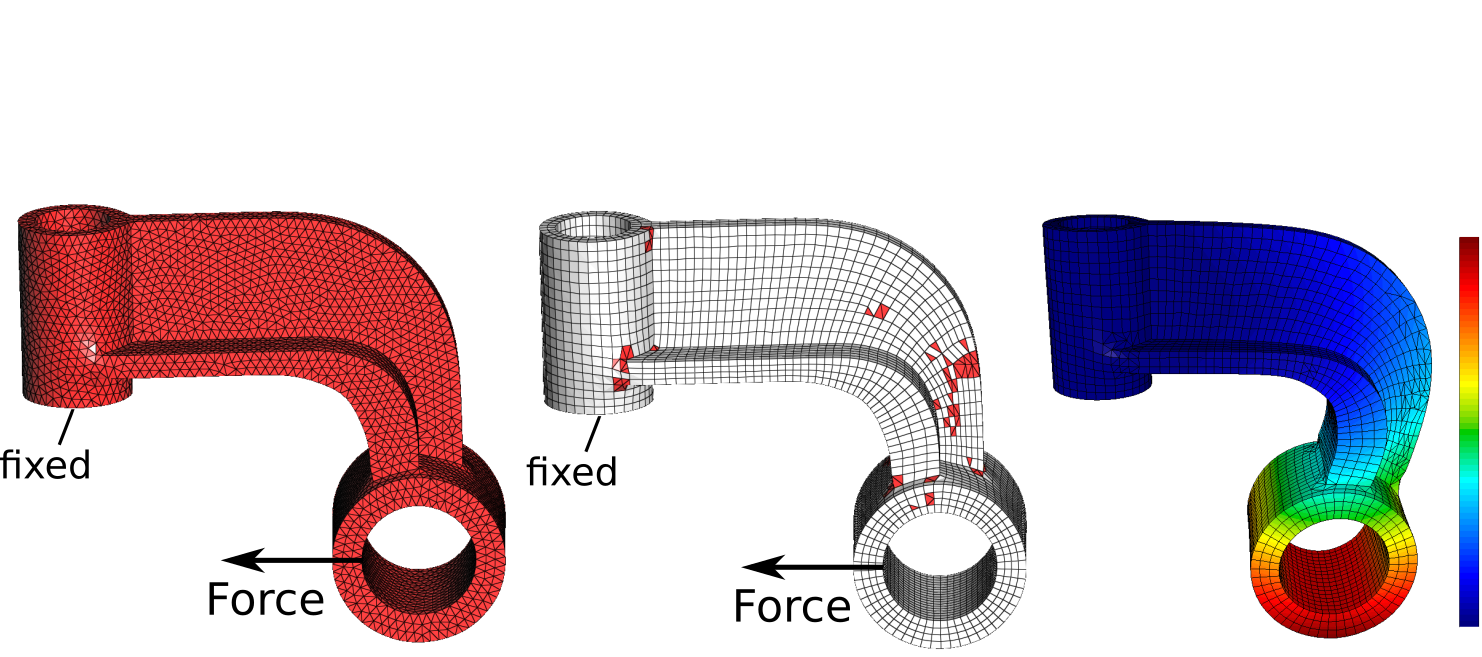Section: New Results
Hexahedral-dominant Remeshing
Representing the geometry of complex objects in a computer is usually achieved by a mesh: the object is decomposed in cells that have a simple geometry. Each cell is defined by a set of facets. The simplest choice is to use meshes with tetrahedral cells that are relatively easy to produce and to work with. However, some applications involving numerical simulations better work with hexahedral cells. Such hexahedral meshes are very difficult to produce, even when it is completely done by a designer. Our objective is to relax the intrinsic difficulties of full hexahedral remeshing by allowing the process to generate a few tetrahedra in the hexahedral mesh (hexahedral-dominant meshes). Our approach is to produce as many hexahedra as possible by filling most of the volume with a deformed 3D grid, and to rely on more classic meshing techniques everywhere else. We also develop tools to evaluate how our remeshing impacts results of FEM simulations.
Generation of Hexahedral-dominant Meshes
The traditional approach to produce hexahedral dominant meshes is by advancing front: first hexahedra are produced near the object boundary, then additionals hexahedra are attached to them. An alternative solution is to consider an hexahedral mesh as a deformed 3D grid: the hexahedral remeshing problem is then restated as finding the (geometric) deformation that will transform the hexahedral mesh into the regular grid. This approach is able to generate very good hexhaderal meshes, but it is often impossible to entirely remesh the input object.
Our objective is to produce hexahedra from the mapping approach, then complete the mesh with traditional approaches that may leave some tetrahedra. We proposed a first solution [9]: we compute a mapping, extract the vertices of the deformed 3D grid, generate a tetrahedral mesh having these vertices, then merge sets of tetrahedra into hexahedra with an extension of [25]. Using the mapping as a heuristic made this solution very competitive with other hexahedral dominant methods. We are now developing a software pipeline that makes it easy for different algorithms (frame field, mapping and classic remeshing) to work together. With a simple implementation of each step, we already observe better performances than previous works, and we foresee many opportunities to improve it.
Impact on FEM Performance
It is admitted by our scientific community that hexahedral meshes are better than tetrahedral meshes for some FEM simulation. We would like to demonstrate evidence of this belief, including fair comparisons with equal running time and/or result accuracy, with the best function basis for each case. For hexahedral dominant meshes, we have developed a new specific function basis devoted to properly link tetrahedral and hexahedral elements. Using a combination of tri-linear and quadratic hexahedra, we can build an approximation space made of continuous functions, even at non-conforming interfaces between hexahedra and tetrahedra. But in practice, hexahedral-dominant meshes are mainly useful to mesh complicated 3D domains. In such cases, there are no analytical solutions of partial differential equations and thus it is not straightforward to evaluate the accuracy of a new numerical method. To measure the differences between finite element solutions defined on different meshes of the same 3D model, we are developing a fast and efficient sampling method which exploits GPU hardware. These topics are addressed in the (ongoing) Ph.D. thesis of Maxence Reberol.



